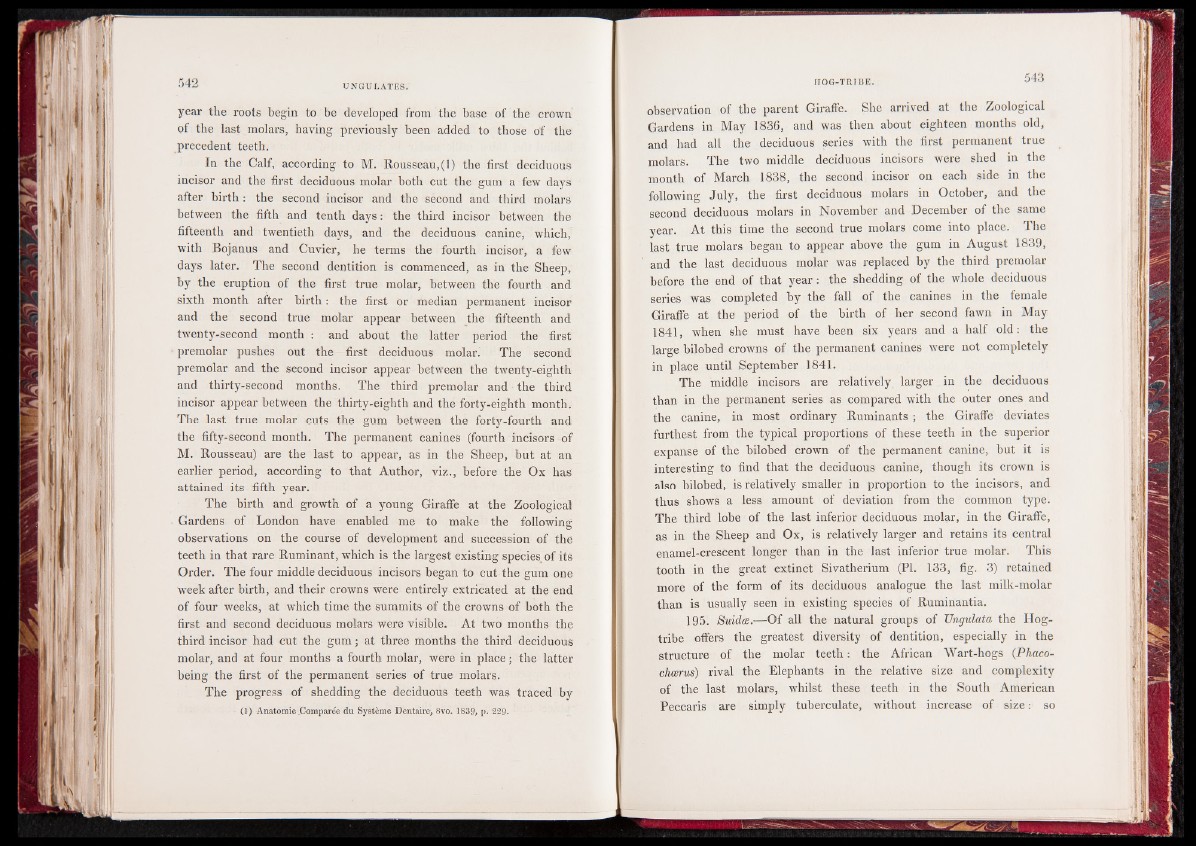
year the roots begin to be developed from the base of the crown
of the last molars, having previously been added to those of the
precedent teeth.
In the Calf, according to M. Rousseau,(l) the first deciduous
incisor and the first deciduous molar both cut the gum a few days
after birth : the second incisor and the second and third molars
between the fifth and tenth days : the third incisor between the
fifteenth and twentieth days, and the deciduous canine, which,
with Bojanus and Cuvier, he terms the fourth incisor, a few
days later. The second dentition is commenced, as in the Sheep,
by the eruption of the first true molar, between the fourth and
sixth month after birth : the first or median permanent incisor
and the second true molar appear between the fifteenth and
twenty-second month : and about the latter period the first
premolar pushes out the first deciduous molar. The second
premolar and the second incisor appear between the twenty-eighth
and thirty-second months. The third premolar and the third
incisor appear between the thirty-eighth and the forty-eighth month.
The last true molar cuts the gum between the forty-fourth and
the fifty-second month. The permanent canines (fourth incisors of
M. Rousseau) are the last to appear, as in the Sheep, but at an
earlier period, according to that Author, viz., before the Ox has
attained its fifth year.
The birth and growth of a young Giraffe at the Zoological
Gardens of London have enabled me to make the following
observations on the course of development and succession of thé
teeth in that rare Ruminant, which is the largest existing species, of its
Order. The four middle deciduous incisors began to cut the gum one
week after birth, and their crowns were entirely extricated at the end
of four weeks, at which time the summits of the crowns of both the
first and second deciduous molars were visible. At two months the
third incisor had cut the gum ; at three months the third deciduous
molar, and at four months a fourth molar, were in place ; the latter
being the first of the permanent series of true molars.
The progress of shedding the deciduous teeth was traced by
(1) Anatomie Comparée du Système Dentaire, 8vo. 1839, p. 229.
observation of the parent Giraffe. She arrived at the Zoological
Gardens in May 1836, and was then about eighteen months old,
and had all the deciduous series with the first permanent true
molars. The two middle deciduous incisors were shed in the
month of March 1838, the second incisor on each side in the
following July, the first deciduous molars in October, and the
second deciduous molars in November and December of the same
year. At this time the second true molars come into place. The
last true molars began to appear above the gum in August 1839,
and the last deciduous molar was replaced by the third premolar
before the end of that year: the shedding of the whole deciduous
series was completed by the fall of the canines in the female
Giraffe at the period of the birth of her second fawn in May
1841, when she must have been six years and a half old: the
large bilobed crowns of the permanent canines were not completely
in place until September 1841.
The middle incisors are relatively larger in the deciduous
than in the permanent series as compared with the outer ones and
the canine, in most ordinary Ruminants ; the Giraffe deviates
furthest from the typical proportions of these teeth in the superior
expanse of the bilobed crown of the permanent canine, but it is
interesting to find that the deciduous canine, though its crown is
also bilobed, is relatively smaller in proportion to the incisors, and
thus shows a less amount of deviation from the common type.
The third lobe of the last inferior deciduous molar, in the Giraffe,
as in the Sheep and Ox, is relatively larger and retains its central
enamel-crescent longer than in the last inferior true molar. This
tooth in the great extinct Sivatherium (PL 133, fig. 3) retained
more of the form of its deciduous analogue the last milk-molar
than is usually seen in existing species of Ruminantia.
195. Suidee.—Of all the natural groups of Ungulata the Hog-
tribe offers the greatest diversity of dentition, especially in the
structure of the molar teeth jj the African Wart-hogs (Phaco-
choerus) rival the Elephants in the relative size and complexity
of the last molars, whilst these teeth in the South American
Pecearis are simply tuberculate, without increase of size: so